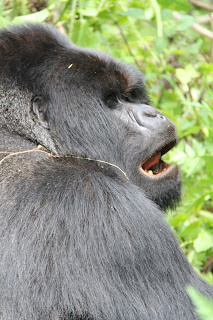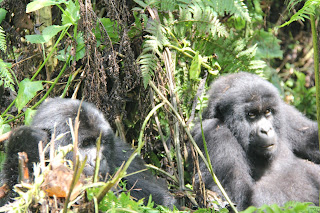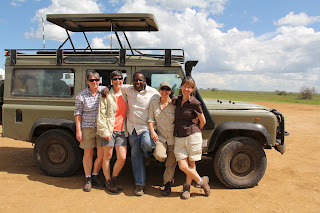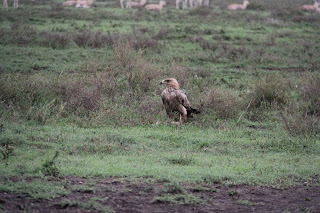We started our visit to Rwanda with a visit to the Genocide Museum. Wow, what an amazing place and an amazing story.
Essentially this event was similar to the German Holocaust. There was separation of people into groups - based on the number of cattle you owned - vs. religion, region of origin, etc. (originally designated by the Belgian government, who has since apologized for their role). Privileges were assigned to one group - hate propaganda grew for the other - media propelled the propaganda - youth became part of a trained militia - by the time the Belgians left, the rift between the groups was huge. Then the situation became unimaginable when a few men in power decided to come up with the ultimate solution - total ethnic cleansing. With financing from the French government, and a UN withdrawal, a 90 day massacre of a million souls began.
We learned so much and it is a true testament to the Rwandan people to see how the country has recovered in such a short period of time. The genocide was only 18 years ago. It taught us most about what we really don't know...the media only tells us so much and sometimes the bigger picture is necessary to really understand what is really going on. Today the main city of Kigali is very modern. The people call themselves Rwandan and have abandoned the class system that was assigned to them. The education system and employment rates are both doing well. Rwanda is looking to other countries not for a hand-out but as investors in their many resources and services.
The country is beautiful
and every inch of land is utilized...mostly for crops. Men own cattle and the
boys in the family look after the cattle. They don't let the cattle graze
freely because they might get into their neighbours crops and wreak havoc. They are also concerned that if the cattle
get sick, they may spread it to other cattle.
So the cattle are kept at home in a corral and the boys are responsible
for gathering grass to feed the cattle.

The girls are responsible for gathering firewood and water. The kids readily and willingly do their
work...because if they don't, it's pretty simple...no food. If there is no water and no wood, there
simply is no dinner. They only do that
about twice and then they get back on track.
As the children become teenagers, things start to change a bit. The girls continue to do the harder labour
while the boys tend the cattle. The
roles become quite traditional and as boys grow up, the traditional roles have
been established. The women work the
hardest. If they earn money, they spend
it on the family first. If a man earns
money, he uses it for himself (maybe buys beer first)...then maybe he spends it on the family. Having children in Rwanda is very
important...especially girls because the father receives a dowry for their hand
in marriage...the dowry is a cow and owning a cow is very important. Having at least one boy is important so that
he can tend to the cow(s). The more
children you have, the more land you can have and the more cows you can have
because the children provide the labour.

Also interesting are the fish farms. Small rabbit houses
are placed over the water. The rabbit droppings fall into the water, leading to
worms, which then feed the fish. Very smart!
As for education, it is provided by the government for 9
years and then if you want to go further you must pay. The public education is good and provides
good discipline. The private education
is expensive, is good education, but not as disciplined. All kids wear uniforms, so there is no
distinction between the wealthy and the poor.
Wealth in a village is determined by the number of cattle you have. If you have a cow (or more than one), a goat
and a chicken, you are very rich.
One of the best things we learned today is that on the
last Saturday of each month, the entire village comes together to work on a community
project. It could be something that the
community needs or the village may choose to help someone in their village
build a house if they can't afford to build a house on their own. We love this idea.
 Sam is great and just a wealth of information. We really like Rwanda. They seem to have their stuff together, have
a plan, have good leadership and are very community minded...very proud of
their country...at least Sam is. He was
brought up in a refugee camp in Uganda as his parents fled the country during
the first genocide in 1962. He returned
to Rwanda right after the 1994 genocide and is very happy to be home.
Sam is great and just a wealth of information. We really like Rwanda. They seem to have their stuff together, have
a plan, have good leadership and are very community minded...very proud of
their country...at least Sam is. He was
brought up in a refugee camp in Uganda as his parents fled the country during
the first genocide in 1962. He returned
to Rwanda right after the 1994 genocide and is very happy to be home.
We warned Sam to get ready for a women's liberation movement!
 Women have already been given the right to sue for family
property rights. Also, women are typically the local judges and wise
people/sage council, particularly since the genocide.
Women have already been given the right to sue for family
property rights. Also, women are typically the local judges and wise
people/sage council, particularly since the genocide.
We had lunch at the Hôtel des Mille Collines, which was the hotel that the movie Hotel Rwanda was based on. It's a strange feeling to be in this place of gorillas and genocide. Rwanda appears to be a friendly, safe place with an eye toward the future and her own plan for how to get there. The amount of progress that has been made emotionally, financially, and politically in less than 20 years since the genocide is quite remarkable.




 After lunch we visited the factory where they make Kazuri
beads. This is a program to employ
single moms and underemployed women.
They make beaded jewelry and pottery and sell it worldwide. It was a very interesting and informative
tour. Interesting that most of the women
didn't look up from their work. Most
would say hello (Jambo) if we said hello first.
After lunch we visited the factory where they make Kazuri
beads. This is a program to employ
single moms and underemployed women.
They make beaded jewelry and pottery and sell it worldwide. It was a very interesting and informative
tour. Interesting that most of the women
didn't look up from their work. Most
would say hello (Jambo) if we said hello first.

















































